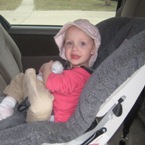
In the April 2011 issue of Pediatrics, the American Academy of Pediatrics (AAP) advised parents to keep their children in rear-facing car seats until age 2 or until the child reaches maximum height and weight limit for the seat. The National Highway Traffic Safety Administration (NHTSA) released new child seat safety guidelines shortly after AAP's publication was released.
Both AAP and NHTSA suggested parents check the maximum height and weight limit on their child's seat before moving them up to the next type of seat. They also suggested older children should ride in a booster seat until they reach 4 feet 9 inches and are between the ages of 8 and 12 years old. At this time, a regular seat belt should fit them properly.
“A rear-facing child safety seat does a better job of supporting the head, neck and spine of infants and toddlers in a crash, because it distributes the force of the collision over the entire body,” Dr. Dennis Durbin, MD, FAAP said. “For larger children, a forward-facing seat with a harness is safer than a booster, and a belt-positioning booster seat provides better protection than a seat belt alone until the seat belt fits correctly.” Previous policy cited age 12 months and 20 pounds as the minimum for transitioning a child out of a rear-facing car seat.
NHTSA Administrator David Strickland pointed out that while all car seats sold in the U.S. must meet federal child restraint safety standards, he said, "Selecting the right seat for your child can be a challenge for many parents. NHTSA's new revised guidelines will help consumers pick the appropriate seat for their child."
As always, children should ride in the backseat of a vehicle until they are 13 years old. Learn more at AAP's Health Children site.








